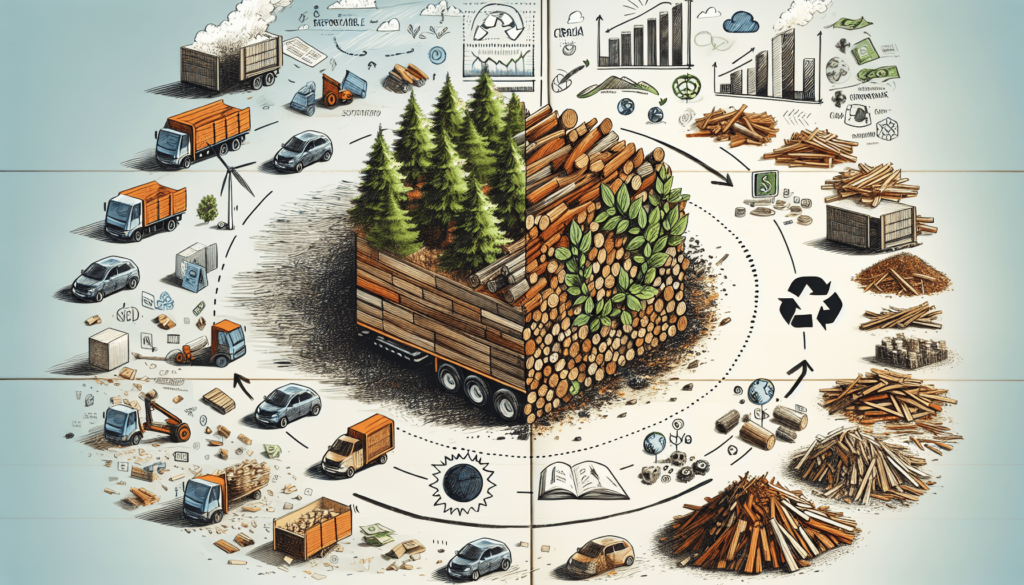In this article, you’ll discover some simple yet effective ways to reduce wood waste. From recycling and repurposing to adopting sustainable practices, there are various strategies you can implement to minimize the environmental impact of wood disposal. By taking these steps, you not only contribute to a more sustainable future but also unlock the potential for creative and innovative uses of wood. So let’s explore how you can make a positive difference in reducing wood waste and make the most out of this valuable natural resource.

Improve Wood Recycling
Increase collection efforts
To improve wood recycling, it is important to increase the efforts to collect wood waste. This can be done by partnering with waste management companies and implementing programs that specifically target wood waste collection. By placing more recycling bins in public areas and providing convenient drop-off points, individuals and businesses will have easier access to recycling their wood waste. Additionally, educating the public about the importance of recycling wood and the proper methods of disposal can help increase participation in collection efforts.
Improve sorting and processing
Once wood waste is collected, it is crucial to have effective sorting and processing techniques in place. This ensures that the wood waste is properly prepared for recycling and minimizes contamination. Implementing automated sorting systems can help streamline the process and increase efficiency. It is also important to invest in facilities and equipment that are specifically designed for wood recycling. By improving the sorting and processing of wood waste, we can increase the overall effectiveness of the recycling process.
Encourage businesses to recycle wood waste
Businesses play a significant role in generating wood waste, particularly in industries such as construction and manufacturing. To improve wood recycling, it is essential to encourage these businesses to recycle their wood waste. This can be done by providing incentives such as tax breaks or grants for companies that implement effective wood recycling practices. Additionally, promoting the benefits of recycling wood waste, such as cost savings and environmental conservation, can help businesses realize the importance of incorporating recycling into their operations.
Promote the use of recycled wood
In order to create a sustainable wood recycling system, it is essential to promote the use of recycled wood. By raising awareness about the benefits of using recycled wood and highlighting its quality and durability, individuals and businesses can be encouraged to choose recycled wood products. This can be achieved through marketing campaigns, educational programs, and collaborations with architects and designers. By actively promoting the use of recycled wood, we can create a market demand that supports the growth of wood recycling initiatives.
Implement Proper Waste Management
Educate individuals and businesses about responsible disposal methods
To implement proper waste management, it is crucial to educate both individuals and businesses about responsible disposal methods for wood waste. This can be done through public awareness campaigns, educational workshops, and online resources. By providing clear guidelines and information on how to properly dispose of wood waste, we can reduce the amount of wood that ends up in landfills or is illegally dumped.
Establish wood waste recycling centers
To facilitate proper waste management, it is important to establish wood waste recycling centers. These centers can serve as designated locations where individuals and businesses can bring their wood waste for recycling. By providing convenient and accessible drop-off points, we can encourage more people to participate in recycling efforts. These centers should have the necessary infrastructure and equipment to sort and process wood waste efficiently.
Create incentives for proper waste management
In order to incentivize proper waste management, it is crucial to create incentives for individuals and businesses to responsibly dispose of their wood waste. This can be done through various means, such as offering tax credits or financial incentives for using designated recycling centers. By providing tangible benefits for proper waste management, we can encourage more people to actively participate in recycling efforts.
Enforce regulations and penalties for illegal dumping
To ensure proper waste management, it is important to enforce regulations and penalties for illegal dumping of wood waste. This can be achieved through cooperation with local authorities, waste management companies, and community organizations. By implementing stricter regulations and actively pursuing legal actions against those who illegally dump wood waste, we can deter such activities and promote a culture of responsible waste management.
Encourage Sustainable Forestry Practices
Promote selective logging techniques
To encourage sustainable forestry practices, it is essential to promote the use of selective logging techniques. Selective logging involves carefully selecting which trees are harvested, considering factors such as age, size, and species. By implementing responsible logging practices, we can minimize the impact on forest ecosystems and ensure the long-term health and sustainability of our forests.
Support reforestation initiatives
Reforestation initiatives are crucial for replenishing forests that have been affected by logging activities. By supporting reforestation projects and partnering with organizations that specialize in tree planting, we can help restore and protect our forests. These initiatives not only contribute to the conservation of biodiversity but also provide economic opportunities for local communities.
Foster partnerships between logging companies and environmental organizations
To promote sustainable forestry practices, it is important to foster partnerships between logging companies and environmental organizations. By working together, these stakeholders can share knowledge and expertise, develop innovative solutions, and implement sustainable practices. Collaboration between logging companies and environmental organizations can lead to a more balanced approach to forestry, where economic growth is achieved while ensuring the preservation of natural resources.
Implement certification programs for sustainable forestry practices
Certification programs for sustainable forestry practices can play a key role in encouraging responsible logging. These programs provide a standardized set of criteria that logging companies must adhere to in order to be certified as sustainable. By implementing certification programs and promoting the purchase of wood products from certified sources, consumers can play an active role in supporting sustainable forestry practices.
Promote Wood Waste Reduction in Construction
Encourage the use of engineered wood products
One way to reduce wood waste in construction is to encourage the use of engineered wood products. Engineered wood, such as plywood and laminated timber, is made from smaller pieces of wood that are bonded together. This allows for more efficient utilization of wood resources and reduces the amount of waste generated during the manufacturing process. By promoting the use of engineered wood products, we can minimize the demand for solid wood and contribute to sustainable construction practices.
Promote modular and prefabricated construction
Modular and prefabricated construction techniques can also help reduce wood waste in the construction industry. These methods involve the pre-manufacturing of building components off-site, which significantly reduces the amount of on-site waste generated during construction. By promoting the use of modular and prefabricated construction, we can minimize the amount of wood waste that ends up in landfills.
Minimize wood waste during construction through efficient planning
Efficient planning is crucial in minimizing wood waste during construction. By accurately estimating the amount of wood needed for a project and carefully designing building components, we can reduce the likelihood of excess materials and waste. Additionally, implementing construction waste management plans that include strategies for salvaging and reusing wood materials can further minimize waste generation.
Facilitate the donation of excess wood materials
To further reduce wood waste in construction, it is important to facilitate the donation of excess wood materials. Rather than disposing of unused or surplus wood, these materials can be donated to local community organizations, schools, or nonprofits that can put them to good use. By establishing partnerships and networks that connect construction companies with potential recipients, we can ensure that excess wood materials are repurposed instead of being wasted.

Encourage Alternative Materials
Promote the use of recycled plastic and composite materials
To reduce the demand for wood and promote sustainable practices, it is important to encourage the use of alternative materials such as recycled plastic and composite materials. These materials can mimic the properties of wood while offering additional advantages such as durability and resistance to moisture and pests. By promoting the use of recycled plastic and composite materials, we can reduce the pressure on forests and maximize the utilization of recycled materials.
Explore alternatives to wood in furniture and packaging industries
The furniture and packaging industries heavily rely on wood as a raw material. To reduce wood consumption in these sectors, it is crucial to explore alternatives to wood. Materials such as bamboo, rattan, and recycled materials can be used as substitutes for wood in furniture production. Additionally, innovative packaging materials such as biodegradable alternatives and recyclable plastics can be utilized instead of traditional wooden packaging. By encouraging the adoption of these alternatives, we can reduce the demand for wood and promote sustainable practices in these industries.
Invest in research and development of sustainable materials as substitutes for wood
Continued investment in research and development is essential for the discovery and advancement of sustainable materials that can serve as substitutes for wood. By allocating resources to research institutions and collaborating with experts, we can explore new possibilities and innovations in material science. This can lead to the development of environmentally friendly and renewable materials that can effectively replace wood in various industries.
Reduce Wood Consumption
Encourage responsible consumer choices
To reduce wood consumption, it is important to encourage responsible consumer choices. This can be achieved through education and awareness campaigns that highlight the environmental impact of excessive wood consumption. By emphasizing the importance of considering alternative materials and opting for sustainable wood products, individuals can make informed choices that contribute to the conservation of forests.
Promote the use of durable and long-lasting wood products
Choosing durable and long-lasting wood products can significantly reduce wood consumption. By investing in high-quality wood products that are designed to withstand the test of time, consumers can minimize the need for frequent replacements and subsequent wood consumption. Promoting the use of such products can be done through consumer education, industry standards, and labeling systems that highlight the durability and longevity of wood products.
Advocate for the repair and repurposing of wooden items
Advocating for the repair and repurposing of wooden items is another effective way to reduce wood consumption. Rather than discarding damaged or outdated wooden items, individuals can explore repair options or find new uses for them. By encouraging the practice of repairing and repurposing, we can prolong the lifespan of wood products and minimize the need for new ones.
Support circular economy initiatives
Supporting circular economy initiatives is crucial in reducing wood consumption. A circular economy aims to minimize waste and maximize resource efficiency by promoting the reuse, repair, and recycling of materials. By advocating for the adoption of circular economy principles, we can create a system that prioritizes the longevity and sustainability of wood products, reducing the overall demand for wood resources.
Create Markets for Wood Waste Products
Encourage businesses to use wood waste for energy production
Wood waste can be utilized as a valuable biomass resource for energy production. By encouraging businesses to invest in biomass energy systems, we can create a market for wood waste products. Biomass energy systems utilize wood waste to generate heat and electricity, reducing the reliance on fossil fuels. Promoting the use of wood waste for energy production not only helps reduce waste but also contributes to the development of renewable energy sources.
Promote the conversion of wood waste into biochar or other useful products
Wood waste has the potential to be transformed into biochar, a highly porous charcoal-like material that can be used for soil improvement and carbon sequestration. By promoting the conversion of wood waste into biochar or other useful products, we can create additional markets for wood waste. Biochar has the ability to enhance soil fertility, retain moisture, and reduce greenhouse gas emissions when applied to agricultural lands. By promoting these beneficial uses of wood waste, we can maximize the value of this resource.
Facilitate the development of innovative uses for wood waste
There is a wide range of innovative uses for wood waste that can be explored to create new markets. For example, wood waste can be processed into particleboard, paper, or even bioplastics. By facilitating the development of these innovative uses and promoting their adoption, we can increase the demand for wood waste and create a circular economy where waste is transformed into valuable resources.
Invest in Research and Development
Funding research on wood waste management and recycling technologies
Investing in research on wood waste management and recycling technologies is crucial for finding new and improved methods to handle and recycle wood waste. By allocating funds to research institutions and organizations, we can support the development of more efficient and sustainable solutions. Research can focus on areas such as advanced sorting and processing techniques, innovative recycling methods, and the utilization of wood waste for value-added products.
Explore innovative solutions for wood waste utilization
Exploring innovative solutions for wood waste utilization is important to expand the possibilities for its application. This can include technologies that convert wood waste into biofuels, chemicals, or construction materials. By supporting research and development in these areas, we can uncover new opportunities for wood waste utilization and maximize its potential as a valuable resource.
Support collaborations between academia, industry, and government
Collaboration between academia, industry, and government is essential for effective research and development in wood waste management. By fostering partnerships and knowledge-sharing between these sectors, we can leverage their respective expertise and resources. Collaborative efforts can lead to the development of practical solutions and the successful implementation of sustainable wood waste management strategies.
Build Awareness and Education
Educate the public about the environmental impact of wood waste
Building awareness about the environmental impact of wood waste is crucial in promoting responsible waste management. By educating the public about the consequences of excessive wood consumption, illegal dumping, and inefficient recycling, individuals can be motivated to take action. This can be done through public campaigns, educational programs in schools and communities, and the dissemination of information through various media channels.
Create campaigns to raise awareness about sustainable wood waste management
Specific campaigns can be created to raise awareness about sustainable wood waste management. These campaigns can focus on the benefits of recycling wood waste, the importance of responsible disposal methods, and the potential impacts on the environment if wood waste is not properly managed. By engaging the public through creative and informative campaigns, we can foster a culture of conscious waste management practices.
Provide resources and information on wood waste reduction and recycling
Providing accessible resources and information on wood waste reduction and recycling is essential for individuals and businesses to actively participate in sustainable practices. This can include guidelines, best practices, and tips on how to reduce wood waste, recycle effectively, and make environmentally friendly choices. By making these resources readily available, we can empower individuals to make informed decisions and take action towards reducing wood waste.
Collaborate with Stakeholders
Work with government agencies to develop and implement policies
Collaboration with government agencies is crucial in developing and implementing effective policies for wood waste management. By engaging with relevant departments and agencies, we can advocate for the establishment of regulations, guidelines, and incentives that promote responsible wood waste disposal and recycling. Collaboration ensures that the necessary framework is in place to support and enforce sustainable practices.
Engage with industry associations and trade organizations
Engaging with industry associations and trade organizations is essential for promoting sustainable wood waste management across various sectors. By collaborating with these stakeholders, we can leverage their expertise, influence, and networks to drive change. Industry associations and trade organizations can play a key role in disseminating information, providing training and resources, and encouraging their members to adopt sustainable practices.
Involve local communities in wood waste reduction efforts
Local communities have a significant role to play in wood waste reduction efforts. By involving them in the decision-making process, raising awareness, and providing opportunities for participation, we can create a sense of ownership and responsibility. Community engagement activities can include workshops, clean-up campaigns, and initiatives that inspire individuals to take action and contribute to wood waste reduction in their own neighborhoods.
Partner with waste management companies for efficient disposal and recycling
Partnerships with waste management companies are vital for the efficient disposal and recycling of wood waste. By collaborating with these companies, we can ensure the proper collection, transportation, and processing of wood waste. Waste management companies can provide the necessary infrastructure, expertise, and resources to optimize the wood waste management system, leading to increased recycling rates and reduced environmental impact.
In conclusion, reducing wood waste requires a comprehensive approach that encompasses various aspects of waste management, sustainable forestry practices, consumer education, and research and development. By implementing effective strategies to improve wood recycling, implement proper waste management, encourage sustainable forestry practices, promote wood waste reduction in construction, explore alternative materials, reduce wood consumption, create markets for wood waste products, invest in research and development, build awareness and education, and collaborate with stakeholders, we can collectively work towards a more sustainable future where the valuable resource of wood is utilized responsibly and efficiently.

Hi, I’m James Gheen, the creator behindWoodRebirth.com. As someone passionate about sustainability and environmental stewardship, I created this pioneering online platform to change how we approach wood waste and pallet disposal. Through detailed recycling and disposal guides, creative DIY projects, and upcycling inspirations, I aim to inspire individuals and businesses to adopt eco-friendly practices in their wood waste management. At WoodRebirth.com, we foster a vibrant community focused on education and engagement, encouraging the sharing of ideas and success stories. Join me in our mission to give wood waste a new lease on life, making a tangible impact on our environment, one pallet at a time.

